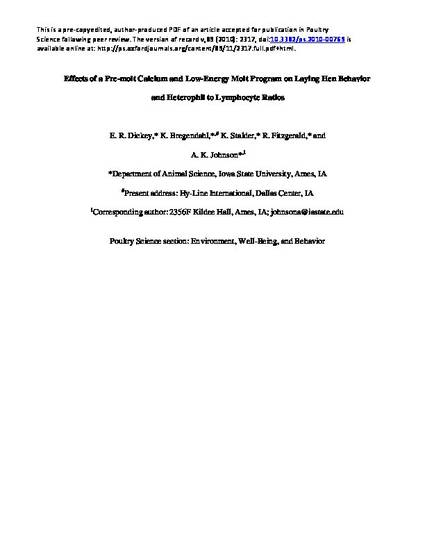
The objectives of this study were to compare the behaviors, postures, and heterophil-to-lymphocyte ratios (H:L) of laying hens housed in a cage system when offered a Ca premolt treatment and low-energy molt diets vs. a traditional feed withdrawal (FW) treatment during and after molt. A total of 144 Hy-Line W-36 hens (85 wk of age), housed 3 hens/cage (413 cm2/hen), were used. Hens were allotted to treatments according to a randomized complete block design, with the cage location and initial BW as the blocking criteria. Six treatments were compared in a 2 × 3 factorial arrangement with 2 Ca premolt treatments (fine or coarse) and 3 low-energy molt diets (FW, soybean hulls, or wheat middlings). The 2 Ca premolt treatments differed only in Ca particle size (fine was 0.14 mm and coarse was 2.27 mm mean diameter). Two postures and 5 behaviors were recorded and H:L was measured. Data were analyzed using the MIXED procedure of SAS, with P < 0.05 considered significant. There were no differences in behaviors, postures, or H:L during the premolt baseline period. The Ca premolt treatment had no carryover effects during or after molt for behaviors or postures. During molt, hens in the FW treatment were more active, and they ate and drank less compared with hens fed soybean hulls or wheat middlings, but there were no differences in aggression, nonnutritive pecking, or sitting. Drinking and aggression during and after molt were not different, but hens postmolt engaged in more sitting and feeding and less activity, nonnutritive pecking, and preening compared with during molt. There were no differences in H:L during or after molt. In conclusion, a Ca premolt treatment did not affect the behavior of the laying hen. The low-energy molt diets did not adversely affect behavior compared with FW and did not increase H:L; therefore, they could be useful alternatives for inducing molt in laying hens.
Available at: http://works.bepress.com/kenneth_stalder/118/

This is a pre-copyedited, author-produced PDF of an article accepted for publication in Poultry Science following peer review. The version of record v,89 (2010): 2317, doi:10.3382/ps.2010-00769 is available online at: http://ps.oxfordjournals.org/content/89/11/2317.full.pdf+html.